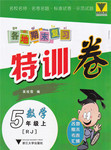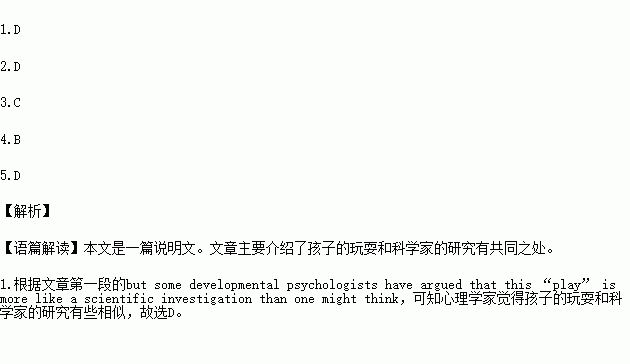题目内容
C
A scientist working at her lab bench and a six-old baby playing with his food might seem to have little in common.After all,the scientist is engaged in serious research to uncover the very nature of the physical world,and the baby is,well, just playing…right?Perhaps,but some developmental psychologists()have argued that this“play”is more like a scientific investigation than one might think.
Take a closer look at the baby playing at the table.Each time the bowl of rice is pushed over the table edge,it
falls in the ground---and, in the process, it belongs out important evidence about how physical objects interact ; bowls of rice do not flood in mid-sit, but require support to remain stable. It is likely that babies are not born knowing the basic fact of the universe; nor are they ever clearly taught it. Instead, babies may form an understanding of object support through repeated experiments and then build on this knowledge to learn even more about how objects interact. Though their ranges and tools differ, the baby’s investigation and the scientist’s experiment appear to share the same aim(to learn about the natural world ), overall approach (gathering direct evidence from the world), and logic (are my observations what I expected?).
Some psychologists suggest that young children learn about more than just the physical world in this way---that they investigate human psychology and the rules of language using similar means. For example, it may only be through repeated experiments, evidence gathering, and finally overturning a theory, that a baby will come to accept the idea that other people can have different views and desires from what he or she has, for example, unlike the child , Mommy actually doesn’t like Dove chocolate.
Viewing childhood development as a scientific investigation throws on how children learn ,but it also offers an inspiring look at science and scientists. Why do young children and scientists seem to be so much alike? Psychologists have suggested that science as an effort ---the desire to explore, explain, and understand our world---is simply something that comes from our babyhood. Perhaps evolution provided human babies with curiosity and a natural drive to explain their worlds, and adult scientists simply make use of the same drive that served them as children. The same cognitive systems that make young children feel good about feel good about figuring something out may have been adopted by adult scientists. As some psychologists put it, ”It is not that children are little scientists but that scientists are big children.”
1.According to some developmental psychologists,
A. a baby’s play is nothing more than a game.
B. scientific research into babies; games is possible
C. the nature of babies’ play has been thoroughly investigated
D. a baby’s play is somehow similar to a scientist’s experiment
2.We learn from Paragraph 2 that
A. scientists and babies seem to observe the world differently
B. scientists and babies often interact with each other
C. babies are born with the knowledge of object support
D. babies seem to collect evidence just as scientists do
3. Children may learn the rules of language by
A. exploring the physical world B. investigating human psychology
C. repeating their own experiments D. observing their parents’ behaviors
4. What is themain idea of the last paragraph?
A. The world may be more clearly explained through children’s play.
B. Studying babies’ play may lead to a better understanding of science.
C. Children may have greater ability to figure out things than scientists.
D. One’s drive for scientific research may become stronger as he grows.
5. What is the author’s tone when he discusses the connection between scientists’ research and babies’ play?
A. Convincing. B. Confused. C. Confidence. D. Cautious.
 中考解读考点精练系列答案
中考解读考点精练系列答案 各地期末复习特训卷系列答案
各地期末复习特训卷系列答案 小博士期末闯关100分系列答案
小博士期末闯关100分系列答案Section B
Directions: Complete the following passage by using the words in the box. Each word can only be used once. Note that there is one word more than you need.
A. account B. adjustable C. appliances D. capture E. decorations F. direct G. experiment H. intended I. operated J. soulless K. squeeze |
Golden Rules of Good Design
What makes good design? Over the years, designers and artists have been trying to 1. the essentials of good design. They have found that some sayings can help people understand the ideas of good design. There are four as follows.
Less is more. This saying is associated with the German-born architect Mies van der Rohe. In his Modernist view, beauty lies in simplicity and elegance, and the aim of the designer is to create solutions to problems through the most efficient means. Design should avoid unnecessary 2.
More is not a bore. The American-born architect Robert Venturi concluded that if simplicity is done badly, the result is 3. design. Post-Modernist designers began to 4. with decoration and color again. Product design was heavily influenced by this view and can be seen in kitchen 5. such as ovens and kettles.
Fitness for purpose. Successful product design takes into consideration a product’s function, purpose, shape, form, color, and so on. The most important result for the user is that the product does what is 6. . For example, think of a(n) 7. desk lamp. It needs to be constructed from materials that will stand the heat of the lamp and regular adjustments by the user. It also needs to be stable. Most importantly, it needs to 8. light where it is needed.
From follows emotion. This phrase is associated with the German designer Hartmut Esslinger. He believes design must take into 9. device that allows us to easily 10. the toothpaste onto our brush.
阅读理解
阅读下列短文,从每题所给的A、B、C、D四个选项中,选出最佳选项。
A
A Language Programme for Teenagers
Welcome to Teenagers Abroad! We invite you to join us on an amazing journey of language learning.
Our Courses
Regardless of your choice of course, you’ll develop your language ability both quickly and effectively.
Our Standard Course guarantees a significant increase in your confidence in a foreign language, with focused teaching in all 4 skill areas----speaking, listening, reading and writing.
Our Intensive Course builds on our Standard Course, with 10 additional lessons per week, guaranteeing the fastest possible language learning (see table below).
Course Type | Days | Number of Lesson | Course Timetable |
Standard Course | Mon-Fri | 20 lessons | 9:00-12:30 |
Intensive Course | Mon-Fri | 20 lessons | 9:00-12:30 |
10 lessons | 13:00-14:30 |
Evaluation
Students are placed into classes according to their current language skills. The majority of them take on online language test before starting their programme. However, if this is not available, students sit the exam on the first Monday of their course.
Learning materials are provided to students throughout their course, and there will never be more than 15 participants in each class.
Arrivals and Transfer
Our programme offers the full package—students are take good care of from the start through to the very end. They are collected from the airport upon arrival and brought to their accommodation in comfort. We require the student’s full details at least 4 weeks in advance.
Meals/Allergies(过敏)/Special Dietary Requirements
Students are provided with breakfast, dinner and either a cooked or packed lunch(which consists of a sandwich, a drink and a dessert). Snacks outside of mealtimes may be purchased by the student individually.
We ask that you let us know of any allergies or dietary requirements as well as information about any medicines you take. Depending on the type of allergies and/ or dietary requirements, an extra charge may be made for providing special food.
1. How does Intensive Course differ from Standard Course?
A. It is less effective.
B. It focuses on speaking.
C. It includes extra lessons.
D. It give you confidence
2. When can a student attend Standard Course?
A. 13:00-14:30 Monday.
B. 9:00-12:30 Tuesday
C. 13:00-14:30 Friday.
D. 9:00-12:30 Saturday.
3. Before starting their programme, students are expected to _____.
A. take a language test
B. have an online interview
C. prepare learning materials
D. report their language levels
4.With the full package, the programme organizer is supposed to_____.
A. inform students of their full flight details
B. look after students throughout the programme
C. offer students free sightseeing trips
D. collect students’ luggage in advance
5. Which of the following may require an extra payment?
A. Cooked dinner.
B. Mealtime dessert.
C. Packed lunch.
D. Special diet.

